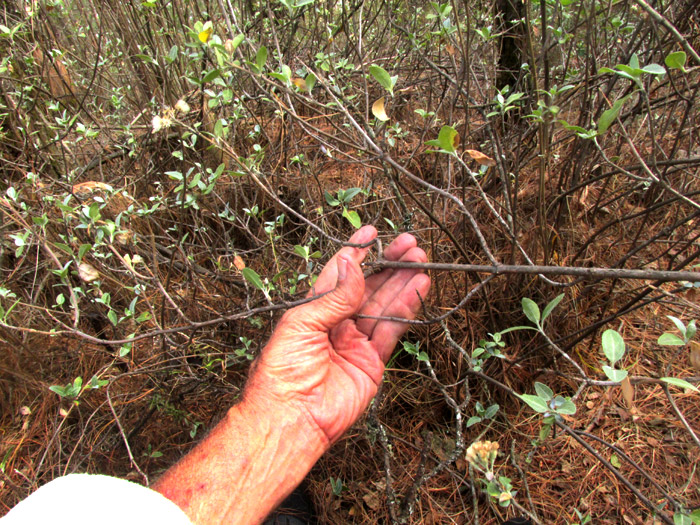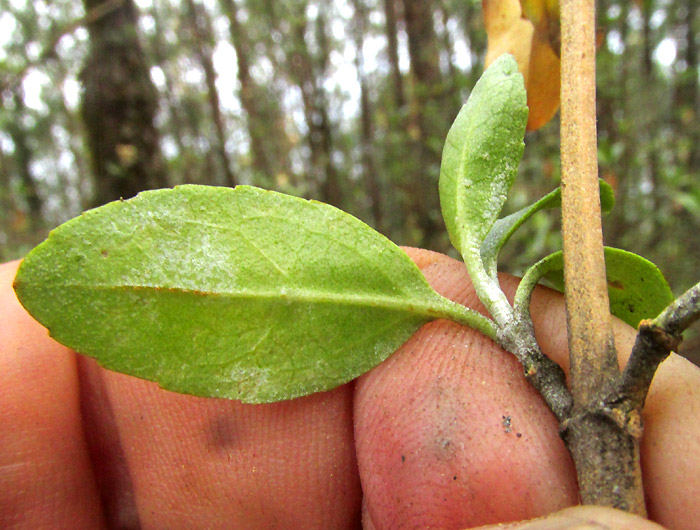Excerpts from Jim Conrad's
Naturalist Newsletter
Entry dated April 19, 2024, from notes taken about 1.5km northeast of Puerto de los Velazquez, Municipality of Pinal de Amoles; N21.138°, W99.667°, elevation ~2835 meters (~9300 feet); oak/pine/fir borderline cloud-forest on limestone bedrock; in the Eastern Sierra Madre Mountains of east-central Querétaro state, MÉXICO
BACCHARIS ZAMORANENSIS

Atop the ridge, a widely spreading, diffuse, woody shrub with several stiff, sprawling branches had lost the previous season's leaves, but at branch tips new leaves emerged and enlarged. Near the above picture's bottom, right, you can see one of the shrub's three or four small inflorescences.

On this member of the vast Composite/Aster/Sunflower Family, the flowering heads bore no petal-like ray florets along their margins. Above, the heads on the picture's right show several slender, cylindrical, wilted disc florets arising along the heads' perimeters, while the interior of each head is occupied with densely packed white pappus bristles. At the image's top, left, a more mature head opens exposing black, one-seeded, cypsela-type fruits topped by spreading pappuses. Note that each flowering head's pedicel is club-shaped -- thick at the top but gradually narrowing below.

Above it's seen that the scale-like phyllaries comprising the bowl-like involucre subtending the cypselae are of different lengths, and overlap one another. There's no sign of scale-like paleas separating cypselae from one another.

Each cypsela bore about 20 pappus trichomes. The trichomes were slender, or "capillary," but tended to become a little bushy at their tips. A few hairs covered each cypsela, and four ribs ran the cypselae's lengths.

At branch tips, new leaves emerged spottily covered with white, cobwebby stuff. Certain leaf margins were endented with a few obscure, low teeth, like the above, but others displayed no hint of teeth. Blades appeared to contain many tiny, resinous glands, but were hairless, unless the white splotches were composed of minute hairs. Blade venation consisted of two or three secondary veins which arched broadly, avoiding the margins; the end of the lowest veins connected with the second veins' midsections.

The shrub's several slender stems arose from a thick mat of dried pine needles.
In highland central Mexico, all the above details point to the genus Baccharis. The 2012 study by Jose Luis Villaseñor and Enrique Ortiz entitled "La Familia Asteraceae en la Flora del Bajío y de Regiones Adyacentes" lists 13 Baccharis species documented for our upland central Mexican region known as the Bajío.
No taxonomic study of the Bajío's Baccharis species sort them out for identification purposes, but by comparing Internet pictures with our own, our bush stands out from the other species. Especially the leaves are distinctive, with their two or three arching veins, the obscure to absent margin teeth, and the somewhat thickish, glandular-resinous blades' slightly brittle texture. The only species whose features match our plant is BACCHARIS ZAMORANENSIS, with no English name.
Of the 13 Baccharis species in our region, Baccharis zamoranensis is the most narrowly endemic, being distributed only in small parts of central Mexico's Guanajuato and Querétaro states. On the Internet the only images of the species I can find are of dried and pressed herbarium specimens of the "type" plant from which the species was formally described and introduced to science; this took place in the 1972 work by Jerzy Rzedowski entitled "Tres Adiciones al Genero Baccharis (Compositae) en Mexico." There's little habitat information about the species, or any other kind of published documentation, for that matter.
Baccharis species are dioecious, meaning that certain plants bear only functionally male flowers, while others produce only female ones. Baccharis species also are described as producing one leaf at each stem node in an alternating fashion, though in the above pictures new leaves at branch tips clearly arise in pairs, opposite one another. I can only guess that once the stems develop beyond the emerging stage and begin elongating, leaves will arise one per stem node.
Finding Baccharis zamoranensis atop this mountain brings up the matter of "mountaintop endemism" -- species of limited distribution restricted to mountaintops. Populations of mountaintop endemic species are by nature often isolated from one another. The 2018 study by Jalil Noroozi and others entitled "Hotspots within a global biodiversity hotspot - areas of endemism are associated with high mountain ranges," found that within the Aster Family in the Irano-Anotolian biodiversity hotspot, " ... the percentage of endemism gradually increased with elevation."
The 2018 study by Benjamin Freeman and others entitled "Climate change causes upslope shifts and mountaintop extirpations in a tropical bird community," says that, worldwide, populations of species adapted to mountain environments are shifting upslope in response to recent temperature increases. Further, "... These upslope shifts are predicted to lead to mountaintop extinctions of species that live only near mountain summits." They add that this process may be more likely in the tropics, where temperature seems to exert a stronger control on species' range limits than in the temperate zone.
I wish I'd realized the rareness of Baccharis zamoranensis when it appeared before me. But I was too concerned with the cold wind storming around me, my running low on water, my exhaustion after climbing into that domain. But, I suppose that that's how it'll be with humans as species disappear at an ever greater rate; no time to kneel before expressions of millions of years of evolutionary wisdom, in admiration and awe, as they simply vanish.